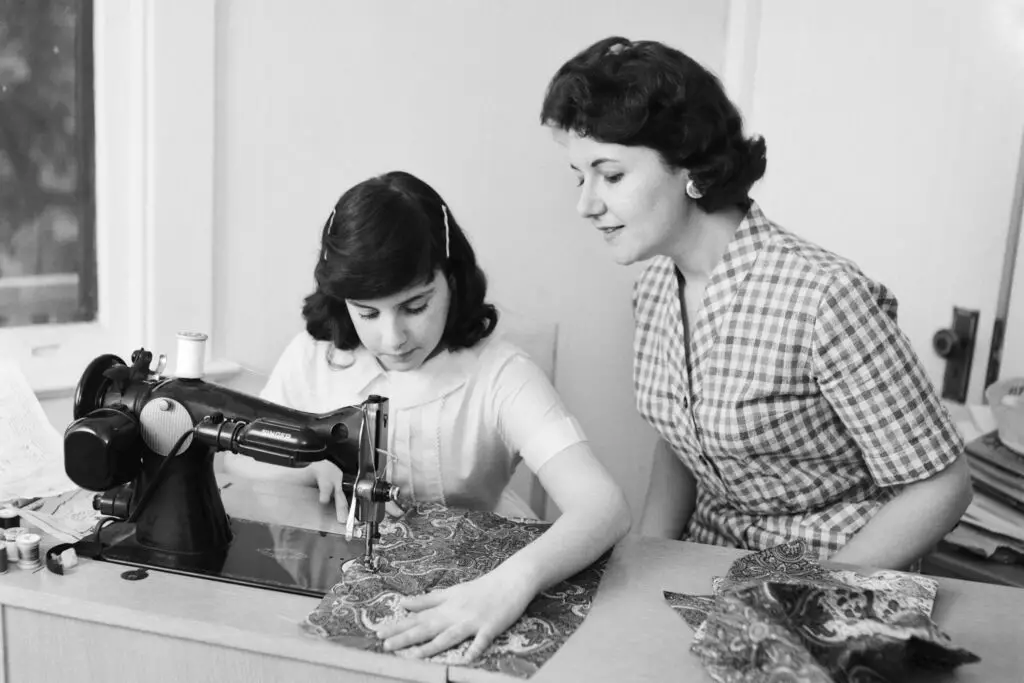1. Cursive Writing

Remember the thrill of getting your first fountain pen and practicing loops and swirls on lined paper? Cursive writing was once a rite of passage in elementary school, complete with worksheets that had arrows showing exactly how to connect each letter. You had to master capital Q’s that looked like fancy 2s and endure hand cramps from long paragraphs. Some kids loved it, others dreaded it, but everyone had to do it says Education Week.
Now, cursive is barely hanging on. Many schools have either dropped it completely or squeezed it into a tiny part of the curriculum. With typing taking over most written communication, cursive is no longer seen as essential. Still, it feels a little sad that something so artistic and personal has become more of a novelty than a skill adds WRDW.
2. Home Economics

If you ever learned how to sew a button, cook spaghetti, or write a check in school, you probably had home ec. This class used to teach the basics of running a household—things like budgeting, meal planning, and laundry. It was practical, hands-on, and surprisingly fun if you didn’t burn your grilled cheese shares the New York Post.
But over the years, it slowly faded out. Schools started prioritizing STEM and college-prep classes instead. Today, most students graduate without ever learning how to hem pants or plan a week’s worth of meals. Home ec still pops up here and there, sometimes renamed “Family and Consumer Sciences,” but it’s a shadow of what it used to be shares PBS.
3. Typing

There was a time when clack-clacking away on a giant keyboard in a typing lab was part of the school day. Typing classes had a rhythm—“A S D F, J K L ;”—and teachers walked around with rulers to check posture. Kids learned not to look at their hands, and hitting 40 words per minute was a badge of honor.
Now, typing is a skill kids just kind of pick up. It’s woven into everyday life so early that formal instruction seems unnecessary. Many schools assume students already know how to type by middle school. Ironically, plenty of teens still hunt and peck on their phones and tablets, but typing class? It’s mostly gone.
4. Shop Class

Shop class used to be a high school staple, filled with the hum of power tools and the smell of sawdust. Students built birdhouses, fixed lawnmowers, and learned to respect a table saw. It was one of the few classes where you could see what you made at the end of the day.
Over time, liability concerns, budget cuts, and a push toward academic rigor pushed shop classes to the side. Some schools turned those rooms into computer labs or STEM spaces. The hands-on skills—wiring a lamp, using a drill, or fixing a chair—are now rare in traditional schools. A few technical programs still offer it, but for many students, shop class is something their parents talk about wistfully.
5. Latin

Once the gold standard of intellectual learning, Latin was everywhere in schools. It sharpened your grammar, helped with SAT scores, and gave you a leg up on big words like “antebellum” or “subterranean.” Some students even took pride in translating ancient Roman texts.
Today, Latin is mostly reserved for the few who attend classical academies or study theology. It’s been replaced by more “practical” languages like Spanish or Mandarin. While it still lingers in private or Catholic schools, the average student will never conjugate “amo, amas, amat.” It’s a niche subject now, far removed from its once-lofty status.
6. Penmanship

Penmanship used to be a class of its own, separate from just learning to write letters. It focused on elegance, precision, and clarity. Students practiced uniform spacing and slant, aiming to write in a style that could almost pass for calligraphy. Neat handwriting was something teachers truly cared about.
Now, as long as the letters are legible enough to scan for grading, that’s often good enough. With so much emphasis on digital communication, penmanship gets maybe a passing mention. Some kids never even learn cursive, much less how to write in a consistent print style. What was once seen as a reflection of character is now mostly overlooked.
7. Driver’s Ed

There was a time when getting your learner’s permit meant you also got to leave class for Driver’s Ed. You’d spend part of your day learning road rules, watching safety films, and even driving a car with a giant brake pedal on the instructor’s side. It was exciting, a little scary, and gave a taste of real-world responsibility.
Today, many schools have cut Driver’s Ed altogether or outsourced it to private companies. The cost, insurance, and liability just became too much for many districts. Now teens often have to get lessons on weekends or evenings outside of school. It’s one more thing families have to coordinate on their own, instead of something everyone did together.
8. Woodworking

Woodshop had a magical feel—taking a raw piece of lumber and turning it into something useful. Whether it was a spice rack, a stool, or a clock, there was pride in sanding and staining it by hand. You learned how to measure twice, cut once, and safely handle all kinds of tools.
But like many hands-on subjects, woodworking took a hit from budget cuts and changing priorities. Tools are expensive, and schools often worry about safety. In many places, the old woodshop has been turned into a storage room or computer lab. It’s a shame, because it gave kids a chance to make something with their own two hands.
9. Calligraphy

Calligraphy wasn’t as common as penmanship, but when it was offered, it felt like art. Learning to control the ink flow, vary line thickness, and shape each letter just right took time and patience. It taught focus, attention to detail, and an appreciation for beauty in writing.
Today, unless you take an art elective or go looking for it, calligraphy has vanished from school halls. With digital fonts and apps that do the work for you, the need to create handwritten invitations or labels just isn’t there anymore. But it had a quiet magic to it. A handwritten quote in calligraphy could stop you in your tracks.
10. Debate

Debate class was where quick thinking met confidence. You learned how to research both sides of an argument, craft your case, and respond in real-time. It sharpened your speaking skills, taught respect for opposing views, and pushed you to think critically. Even if you were nervous, it made you feel powerful.
While some schools still have debate clubs, formal debate classes have become rare. They’ve been replaced by broader communication courses or cut to make room for test prep. It’s a loss, because debate encouraged curiosity, courage, and clarity. These are skills that don’t always get nurtured in today’s curriculum.
11. Agriculture

In farming communities, agriculture classes were once as common as math or English. You’d learn about crops, soil health, animal care, and basic mechanics. It wasn’t just for future farmers, either—plenty of kids liked the hands-on science of it all. You might even raise a plant or small animal as part of your grade.
Now, unless you’re in a specialized rural district, agriculture has mostly disappeared from the classroom. FFA still exists in some areas, but the everyday school subject has faded. With fewer kids growing up on farms, it’s no longer considered essential. Still, there’s a strong case for bringing it back, especially with today’s focus on sustainability and food sources.
12. Film Photography

Loading a roll of film, winding it carefully, and learning to shoot without seeing the results instantly was once part of photography class. You had to think through every shot, then wait to develop it in the darkroom. The smell of chemicals and the red lights gave it all a mysterious, hands-on charm.
Today, most photography classes are digital-only. Film photography is more of a boutique hobby now, reserved for a few art programs or passionate hobbyists. It’s expensive, slow, and unpredictable—but also deeply rewarding. That sense of anticipation and craftsmanship just isn’t the same with instant filters and smartphone edits.
13. Music Theory

Music class is still around, sure, but music theory used to be its own focused subject. Students learned how to read sheet music, understand chord progressions, and even compose short pieces. It went beyond playing instruments and taught the structure behind the sound.
Now, many schools have cut back or simplified music programs, leaving theory behind. It’s hard to squeeze it in with so many academic requirements crowding the schedule. A few magnet or arts schools still teach it in-depth, but it’s no longer standard. For many, music class is now more about performance than understanding.
14. Current Events

There used to be time set aside just to discuss what was happening in the world. Students brought in newspaper clippings or watched classroom news broadcasts, then had open discussions. It helped you understand politics, geography, and why something halfway across the world mattered to you.
Today, current events are often skipped or briefly mentioned in social studies. With so much polarization, some schools are wary of diving into modern news. That’s a missed opportunity, especially when kids are constantly exposed to headlines online. A dedicated class could help them make sense of it all, but now it’s mostly left to chance.
